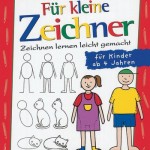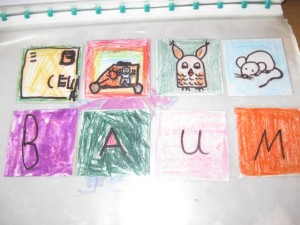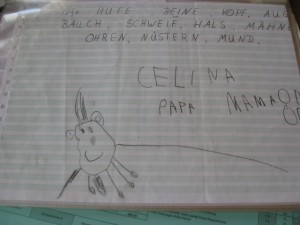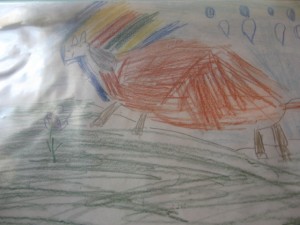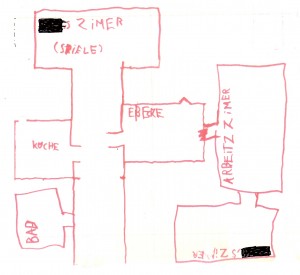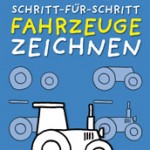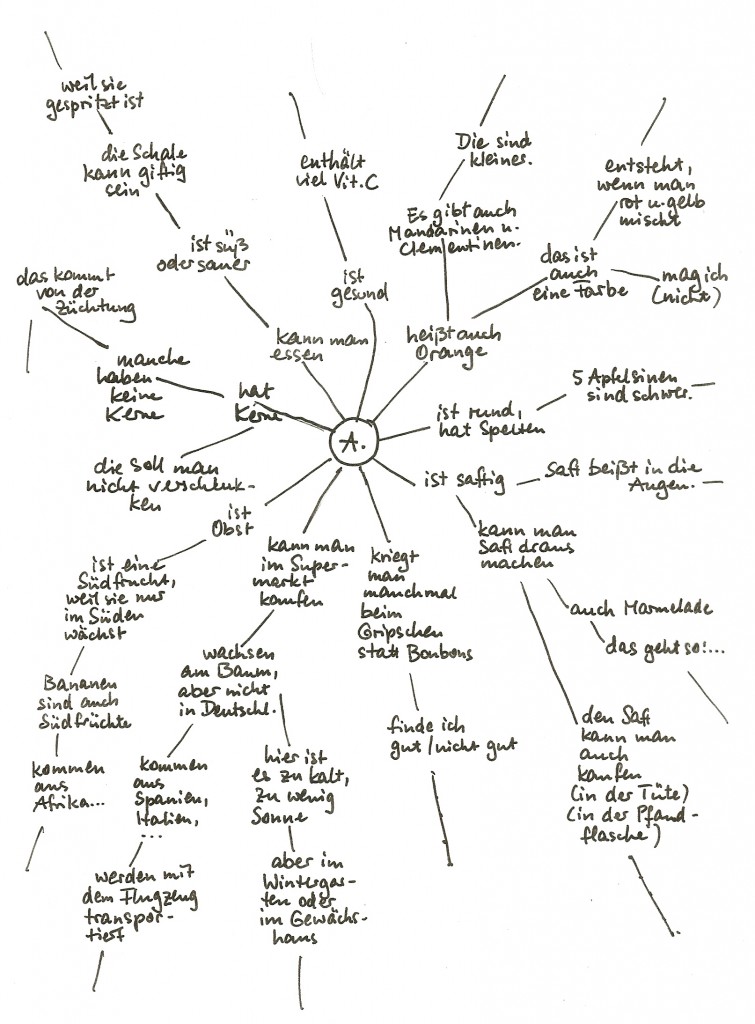by Arno Zucknick
I came to the IHVO Certificate Course as a career changer. Though I was not unfamiliar with the topic of giftedness, I was more aware of it with regard to youths and adults. In order to take part in the course I was required to spend one day per week (for 2 years) at a kindergarten for practical work experience. I did so along with my usual work load as a freelance teacher in adult education, and I worked in two different kindergartens consecutively. This is how I familiarised myself with the age group 3 – 6 years while learning how kindergarten work “goes”.
… in a nutshell …
A 3-year-old is interested in writing. The author works one or two half-days per week at the little boy’s kindergarten and regularly takes out half an hour to support the little boy in his learning endeavour.
The progress the boy makes is astonishing, and so is the joy and the playful ease with which he explores writing.
I was well accepted into both kindergartens. There was no monetary compensation for my work but a few of the colleagues in the team showed interest in the topic and supported my projects.
Jerome speaks well
Jerome (3;8) caught my attention the very first day. He was the only one who answered the question about his name and age in a complete and correct sentence (“My name is Jerome and I’m 3 years old, too.”), while other 3- or 4-year-olds would say their name and then show their age with their fingers.
His verbal skill sticks out. Without difficulty he casts his thoughts into compound sentences with main and subordinate clause. All the while his speech is fluent, not like that of many others in the group who, as very small children often do, need to take a breath in between parts of a sentence.
After a few games and talks with Jerome and a talk with his parents I started spending half an hour with Jerome alone on some of the days I was at the kindergarten. The rest of the time I was dealing with the group as a whole.
The topic presently on his mind is writing, so that is what we are doing together.
My pedagogic approach to working with Jerome
The fact that we are working together is not a result of Jerome’s wish to do so, but it was my initiative. Thus I find it important to remind myself not to hold up any didactic expectations. My work is result-oriented only in the way that I intend to offer an activity that is fun for Jerome and that addresses his present interests. Furthermore I aim to be as attentive as possible and observe him as well as myself closely. He can quit any time and has no obligations whatsoever. It will always be up to him whether we do something on a specific day and spend another 30 minutes inside, while the other children are already outside playing.
I also want to avoid any kind of teacher-student scenario. We will be dealing with the topic playfully and the focus is on the shared activity, where the older and more experienced part only stands by the younger one’s side providing some hints and suggestions here and there while letting the younger one lead.
Our sessions did not take place on each and every day I spent at the kindergarten. Sometimes I was in another group, on some of the days I was under the impression that Jerome just was not quite up for it, or the day’s schedule was so tight that he would have missed out on getting to play outside during the first half of the day if we had stayed inside. Jerome has a normal desire for physical activity and our activities were not to get in the way of that.
Our first sessions
Since Jerome also loves drawing, it usually went like this: we would draw a picture on a freely chosen subject and add corresponding words to the sketch. At the first session it was his friend’s name ‘Felix’ that interested him. He was already able to write it. So Jerome went ahead and made a drawing of Felix and added his name in writing. I drew my own picture of the two of them with the clothes that they were wearing that day and wrote their names on top of the figures. Jerome then added the names on my picture in his own writing and also wanted to write my name on it. I wrote it for him to see and he copied it. Up to now we have been writing in capital block letters only.
Right at this first session I noticed that Jerome sometimes writes in mirror writing, apparently without being aware of it. I pointed it out to him avoiding to call the wrong direction in which he was writing ‘wrong’, but instead used the term ‘mirror writing’ and showed him, that you see the word in mirror writing correctly, when you hold it up against the light and look at it from behind the sheet. That blew his mind. He had written my name correctly and, when I proposed that he write it in mirror writing, he did so without a mistake on his first attempt. I found that amazing, especially with regard to the ‘N’ in ARNO.
We also discovered that for some of the letters it does not make any difference which way you write them. Mirror writing stuck around for a while and I kept pointing it out to him when he had used it again.
At that same first session it also emerged that he was able to spell the words he was writing correctly. He did so, without having to be prompted, every time after he had written a word. And he pronounced the letters correctly when naming them, for example “enn” for “N” instead of the pure nasal “nnn”. I was officially impressed.
Topics that came up in the following sessions included “pirates”, “underground” (train), “names of other children in the group”, “owl”, “elephant”. When we were working on “pirates” I was once more reminded of his large vocabulary when he called a sword I had drawn with a curved blade “a sabre”. During the same session he explained to me how a plane starts, namely that it has to roll and accelerate on the “runway” first and then finally “lifts off”.
When dealing with the “underground” (train) he was fascinated by the corresponding street sign with the letter “U” cut out in white. This negative-method of writing a letter by drawing its outlines and colouring the background, leaving the letter’s inside untouched and thus white, really tickled him.
We then did the same thing with the “S” on a green backdrop, as appearing on the “S-Bahn”-sign (S-Bahn = Stadtbahn = city railway). That was a little trickier but he would not be discouraged.
At a further session we had newly bought plastic letters with magnets attached to them. When I laid the words “mama” and “papa” he first said “I can’t read that” (as written words they were new to him), but then he managed to read them by deciphering the letters one by one. He was visibly having fun figuring something out that was unknown to him. Then he wanted to lay words and had me read them out to him.
He proceeded to laying extremely long imaginary words, using up the entire alphabet, and had me read them out. It did not bother him a bit that the words I vocalised were no real words. On the contrary, he was excited to see that any given combination of letters could be read out and thus be turned into sound. And was he having a ball listening to the funny sounds that emerged and watching me twisting my tongue!
Due to room shortages we had to do one of our sessions in the dance and gymnastics room, so we took all our writing and drawing materials with us. However, this day Jerome did not feel like writing so much, he had trouble concentrating. Maybe it was the different room with all its many objects and musical instruments lying around.
That day he seemed to be up to something else: he wanted to test me. He began by playing around with the instruments and at one point even ran out of the room, as if to check whether I would come running after him. And then there was Robert, a boy from our group, showing up and distracting Jerome. I suggested that it might be a better idea to just quit for today and go playing outside; he thought so, too. In the dressing room he took up the topic himself, wondering who else in the group might have a name that starts with “J”. So he climbed on the bench and worked himself through all of the coat hooks, reading the names on them. He identified the names of Josephine and two or three other children from the neighbouring group.
Our sessions usually lasted 30 to 45 minutes. Then we always went to join the other children outside.
Results and observations
After the first seven sessions I made a preliminary assessment. The work with Jerome had been great fun for me. He himself had looked into reading and writing and learned to write a few new words.
The simple fact that Jerome had not lost interest along the way is a major success for me personally. The playful approach is not my forte and I do not experience myself as very imaginative in that respect. I tend to grasp subject matters more on an analytic/abstract level which makes exercises and repetitions tedious for me. Consequently I do not easily come up with creative tutorial ideas on a child-like level.
It was therefore quite adequate to have Jerome lead the way, simply going along and throwing in a piece of advice or giving some help here and there. This approach appears to have worked.
Jerome showed great sensitivity in some moments, especially when he was under the impression that I wanted to test him, as for example when I would ask him to tell or explain something because I wanted to see whether he had really understood it – these were occasions when he acted with great self-determination, clearly deciding for himself how far he would go with that.
It was mostly I who initiated the individual sessions. As far as I can remember he only once brought it up himself and asked “whether we were writing again today”. At the same time he never turned the offer to do some writing down. Jerome shows hints of the typical characteristics indicating giftedness; for example his complaint that he often feels disturbed in his present activities and he would wish for a room where he can withdraw.
The shared times have intensified Jerome’s and my relationship. We are quite close and he considers me his friend, which I’m very happy about.
For the future I wish our trusting relationship develops further and we both keep having fun and being inspired by one another.
Jerome wants to learn reading and writing for real, but playfully
At our last session I asked Jerome whether he wanted to learn how to read and write “for real”, which he did. The parents had told me that he often joined his brother (1st form) in doing his homework assignments from school, so I considered it just the more to be the right time to work on the alphabet with a little more structure and focus.
For this I created a little folder with separate sheets for each individual letter. In the upper right corner it had the respective letter – large and only in outlines – to be coloured, then the main section was free for a drawing and underneath there was space and a line on which to write a sample word that started with that letter.
We would like to point out the very nice TINTO Letter-Booklet,
See: Picture books, Storybooks, Non-Fictional Books and Stories
In the recent past there have been signs of jealousy and animosities between the children in the group because of my increased focus on Jerome.
I had a talk with Jerome and we managed to come to some agreements that would ease the problem – one major part of the deal was, that I would offer activities for the whole group along the line of cognitive advancement.
More about this particular problem and my talk with Jerome see in:
On-on-One Advancement, Mentoring
In the meantime it has been Jerome’s 4th birthday.
The folder I had prepared and which Jerome and I call ‘primer’ has been well accepted by Jerome and we are working with it. Interestingly and surprisingly for me, it is not the drawing part that Jerome is mainly interested in. He largely focuses on writing. In our more productive sessions his concentration is astonishing and oftentimes he will write long compound words like “Jagdfieber” (hunting fever) “Haferbrei” (oatmeal). He does need some help here and there, but on the whole he writes the words very much by himself, he will occasionally ask whether he has written something “the right way around” or not (mirror writing) and then he always wants me to read the word out to him.
The words we chose to write usually come up during our conversations at the beginning or they are from what he tells me about his life. “Oatmeal”, for instance, came up when he told me that he had eaten a humongous bowl of oatmeal that morning.
Another time he tells me that his mother had told him about how she used to cross the border entering the “DDR” (Deutsche Demokratische Republik = German Democratic Republic/GDR). Now he wants to know what that means – DDR – and how to write it. I spell it for him and he writes it. The “D” immediately catches his attention because “it is almost like a T” (the sound of it) and then it cracks him up that the “T” is in itself the whole word “tea”.
He still enjoys the long imaginary words consisting of chaotically arranged sequences of letters, which I have to read out. Sometimes he writes them, sometimes he lays them using the magnet letters, which we have been using in almost every session ever since we got them. Most of the time these words contain long sequences of consonants which can hardly be pronounced and it is hilarious for him when I try to articulate them. Consequently we keep running into the problem that it cannot be done.
When I took this as an opportunity to tell him about the difference between vowels and consonants and asked him to squeeze in a few vowels he did so without hesitating and got it right without any further help.
After the first 7 sessions there has been a new observation:
Jerome initiates the sessions
It has been noticeable that Jerome, if we haven’t done anything in a while, starts urging me that ”today we write again”. He appears to find the sessions stimulating and he demands this activity quite explicitly if the last session seems too have been long ago.
The sessions generally are the more productive the more unstrained they are. Jerome will become clumsy and demotivated the more I try to structure the session and work systematically on the alphabet. That is how after two more sessions with the primer we are no further than the letter “C”, even though he already knows quite a few more letters and even uses them. I keep having to remind myself that there is no “test to be passed” and that I can legitimately go with his intuitive and playful approach.
Gifted people often have their very own ways of learning, which do not necessarily follow any conventional learning strategies.
Jerome gets to know the entire alphabet
For three months we have been working ourselves straight through the alphabet using the primer, and we are now at the letter “S”, where all the other letters have come up on the way by now, because they were part of the sample words we had dealt with in connection with previous letters. It has taken us 9 sessions to get there.
It is fair to say that Jerome has by now got acquainted with the entire alphabet including the umlauts. He uses the word “alphabet” as if it were the most natural thing to do so at his age.
In the recent past the occasions on which other children wanted to join in on a session have become fewer, which has had a positive impact on Jerome’s concentration. I assume that those who had joined in realised that it just was not for them to be working on letters all the time and to be so focused.
It is a pity that there are not more children in our group who share the same interest in focused work on the letters. It would have been much better for Jerome. This way we were stuck with the one-on-one scenario.
See: Integrative Focus Kindergartens for the Advancement of Gifted Children
Throughout all our sessions I was able to observe Jerome continuing to work with undiminished interest and great concentration. Oftentimes he virtually stormed through the primer “completing” one letter, then the next.
And he showed great imagination in finding corresponding sample words and never avoided long words. For the letter “N” he chose “Nussschokolade” (nut chocolate). “D” made him think of “Durst” (thirst) and he quickly noticed that, while “Durst” was easy to write, how could it be drawn? His solution was: a glass of beer. And he could then even write the word beer on the glass.
Peculiarities as for instance the sibilants (hissing sounds) “ch” and “sch” (engl: sh) or the principal occurrence of a “U” after a “Q” did need explanation but were then used correctly, no further help necessary.
It was so refreshing to experience his readiness of mind. One time he wrote an “S” in the middle of a word in mirror writing, and I vaguely pointed out to him that there was something wrong with the word. He immediately identified the “S” as the culprit, held the sheet up against the light looking through it from the back, and said: “That’s the right way!”.
When working on the “Q” he had chosen the word “Qualle” (jellyfish). The direct progression from “L” to “E” gave him the idea that the “E” is simply a combination of “F” and “L”. We then explored more such “letter combinations” as in ”P” being a part of “B” or “R”.
Jerome knows how to learn now
In the course of the project he developed a number of learning strategies all by himself. For example, every sheet he made outside of the primer he would insert in the primer together with the corresponding letter sheet. When writing new words he would research certain letters by going back through the pages.
Another strategy was to try a letter which he knew but was not sure about on a separate sheet first and have me confirm it. Only then would he transfer it to the sheet in the primer. If – as sometimes happened – there was not enough space to finish the sample word he would just start writing around the corner by rotating the sheet.
All the while he kept surprising me with his large vocabulary. About the jellyfish he told me that it had “Tentakeln” (tentacles), and before I knew it he was writing the word “Tentakeln”.
He also liked making use of alternative ways of writing, as with the plastic letters, which would be laid out to form words on a magnetic table, or the newly bought board with embossed letters that were hatched on the surface so that they could easily be transferred onto paper by rubbing a pen on the sheet while holding the sheet down on them. All of these materials he handled with the greatest of ease. At the same time he clearly felt when it was time for him to make the move and play outside. He would say so clearly, and the session was over.
What has been achieved?
Unfortunately my work with Jerome had to come to an end. With regard to the requirements for the Certificate Course I had to move on to another kindergarten to broaden the basis of my practical work experience.
I had the chance to talk to Jerome’s mother at the Summer Festival. She spoke very positively of my work with Jerome and thanked me for it. He had liked it and she, too, was of the impression that it had done him good. Since he did show a very curious mind at home, too, she was sure it had been a very valuable activity for him.
From my point of view the shared time has been beneficial for both of us. It will certainly have been a good thing for Jerome to get the attention and to focus on a major interest of his while being competently accompanied. I would conclude this from the fact that – aside from the first few sessions – the sessions were always initiated by him.
With my help he has successfully learned how to write (if only in block letters for the time being); mow he can take it from there all by himself.
See also: One-on-One-Advancement, Mentoring
Published in German: June 2012
Copyright© Arno Zucknick, see imprint
Translation: Arno Zucknick


